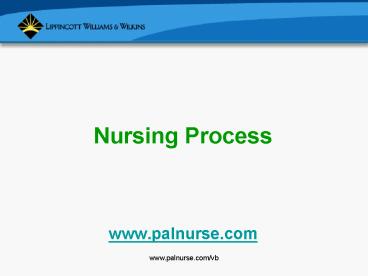Nursing Process - PowerPoint PPT Presentation
1 / 24
Title: Nursing Process
1
- ??? ???????? ???????? ??????? ?????????
- ??????? ?????? ????? ?????? ??? ???????????
???????? - Nursing Process
- ??????? ?????????????? ????? ?????????????
- www.palnurse.com
2
Definition of the Nursing Process
- An organized sequence of problem-solving steps
used to identify and to manage the health
problems of clients - It is accepted for clinical practice established
by the American Nurses Association
3
Characteristics of the Nursing Process
- Within the legal scope of nursing
- Based on knowledge-requiring critical thinking
- Planned-organized and systematic
- Client-centered
- Goal-directed
- Prioritized
- Dynamic
4
Steps of the Nursing Process
- Assessment
- Diagnosis
- Planning
- Implementation
- Evaluation
5
Assessment
- Systematic collection of facts or data
6
Types of Data
- Objective data-observable and measurable facts
(Signs) - Subjective data-information that only the client
feels and can describe (Symptoms)
7
Sources of Data
- Primary source Client
- Secondary source Clients family, reports, test
results, information in current and past medical
records, and discussions with other health care
workers
8
Types of Assessments
- Data base assessment
- Focus assessment
9
Organization of Data
- Grouping of related information
- Organization of assessment data into small groups
to be analyzed
10
Nursing Diagnosis
- Health issue that can be prevented, reduced,
resolved, or enhanced through independent nursing
measures - Nursing Diagnosis Caregories
- Actual
- Risk
- Possible
- Syndrome
- Wellness
11
Diagnostic Statements
- Name of the health-related issue or problem as
identified in the NANDA list - Etiology (its cause)
- Signs and Symptoms
- The name of the nursing diagnosis is linked to
the etiology with the phrase related to, and
the signs and symptoms are identified with the
phrase as manifested (or evidenced) by
12
Collaborative Problems
- Physiologic complications whose treatment
requires both nurse- and physician-prescribed
interventions. - They are an interdependent domain of nursing
practice
13
Collaborative Problems-Nurses Responsibility
- Correlating medical diagnoses or medical
treatment measures with the risk for unique
complications - Documenting the complications for which clients
are at risk - Making pertinent assessments to detect
complications - Reporting trends that suggest development of
complications - Managing the emerging problem with nurse- and
physician-prescribed measures - Evaluating the outcomes
14
Planning
- The process of prioritizing nursing diagnoses and
collaborative problems, identifying measurable
goals or outcomes, selecting appropriate
interventions, and documenting the plan of care. - The nurse consults with the client while
developing and revising the plan.
15
Setting Priorities
- Determine problems that require immediate action
- Maslows Hierarchy of Human Needs
16
Short-Term Goals
- Outcomes achievable in a few days or 1 week
- Developed form the problem portion of the
diagnostic statement - Client-centered
- Measurable
- Realistic
- Accompanied by a target date
17
Long-Term Goals
- Desirable outcomes that take weeks or months to
accomplish for clients with chronic health
problems
18
Goals for Collaborative Problems
- Goals for collaborative problems are written from
a nursing rather than from a client perspective. - The focus on what the nurse will monitor, report,
record, or do to promote early detection and
treatment.
19
Selecting Nursing Interventions
- Planning the measures that the client and nurse
will use to accomplish identified goals involves
critical thinking. - Nursing interventions are directed at eliminating
the etiologies. - The nurse selects strategies based on the
knowledge that certain nursing actions produce
desired effects. - Nursing interventions must be safe, within the
legal scope of nursing practice, and compatible
with medical orders.
20
Nursing Orders
- Directions for a clients care
- Identifying what, when, where, and how for
performing nursing interventions - Nursing orders are signed to be accountable
21
Communicating The Plan
- The nurse shares the plan of care with nursing
team members, the client, and clients family. - The plan is a permanent part of the record.
22
Implementation
- Carrying out the plan of care
- The nurse implements medical orders and nursing
orders - Implementation involves the client and one or
more health care team - The information in the chart shows a correlation
between the plan and the care that has been
provided. - Nurses are accountable for carrying out nursing
orders and physician orders.
23
Evaluation
- The way nurses determine whether a client has
reached a goal. - It is the analysis of the clients response,
evaluation helps to determine the effectiveness
of nursing care.
24
- ??? ?????? ?????? ??? ???????? ????????????
- ??? ?????? ??? ????? ??????????? ????? ???????
- ??? ???????? ??? Lippincott ?????????????
- ??????? ???????????? ????? ???????????
- WWW.PALNURSE.COM































